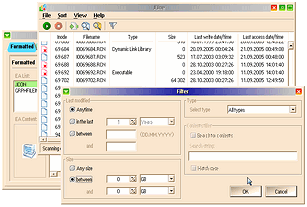|
|

|
AD: Upgrade ArcaOS to NeoWPS level
- Install original PNG icons drawed by designer, specialized at OS/2 adornation.
- Install eSchemes 2019 to change colors and buttons on desktop.
|
JFS file system for eComStation |
TITLE: JFS file system for eComStation
DATE: 2005-12-09 21:45:12
AUTHOR: eCo Software
Please use online translator
go to http://translate.google.com
and request the translation of http://en.ecomstation./showarticle.php?id=139
to your language |
Every modern operating system has its own file system, eComStation is no exception.
JFS (Journaling File System) is a native file system for eComstation.
What does "Journaling" mean? This file system uses a special area on the disk (named "journal") which is
used to write changes which occur during operation. Usage of the journal allows a significant
decrease in time of data update and increases filesystem reliability.
Modern versions of the JFS filesystem were developed by IBM corporation for OS/2 Warp Server for e-Business.
Later it was ported to IBM AIX and Linux. The goal of the developers was to provide high performance,
reliability, and scalability on SMP machines. eComtation developers aspire to follow the goals
defined by IBM corporation and have continued the development of the JFS filesystem since 2001.
Innovations implemented towards the fall of 2005:
- speed-up of eComStation operating system installed on volume with JFS filesystem (disk operations may achieve 100% increase in speed).
- increased filesystem reliability (fixes in UJFS.DLL).
- implementation of recovery tools for JFS volumes.
- support for flash-disks with JFS filesystem.
Installation of eComStation on JFS volume
You can install eComStation on a bootable JFS volume using the OS installer. eComStation may be installed on any
DOS-compatible volume. The installation procedure does not differ from installation to an HPFS partition.

Looking at the diagram, you can see the speed of the operating system boot to graphic and text modes, the speed of loading some popular applications. Thus, you can be assured that JFS gives gains up to 100% in comparison with HPFS filesystem.
The only thing that it is necessary to achieve these performance gains is to install the operating system onto a bootable JFS volume.
Why does launching and operating speed increase? Cache is the reason.
Thanks to the fact that system INI and DLL files are placed on a JFS volume, JFS.IFS driver caches them
much more efficiently than the HPFS filesystem does. All calls from applications to system libraries
require less time because the libraries reside in cache (memory).
JFS service utilities
 Another important goal in addition to perfomance is reliability. Certainly, an absolutely
reliabile filesystem does not exist. Filesystem reliability is a combination of stability to failures
and the availability of recovery tools. It is possible to discuss how great the probability to loose
data on JFS is. If viewed from this point, JFS is very reliable. There are few failures that can be attributed to JFS,
data recovery tools for JFS exist. The unique utilities JRescuer and June allow restoration of data from a
damaged JFS volume and can restore deleted files also. These utilities will work without the JFS.IFS driver loaded,
i.e. explore the volume and search user data without the JFS driver assistance.
Another important goal in addition to perfomance is reliability. Certainly, an absolutely
reliabile filesystem does not exist. Filesystem reliability is a combination of stability to failures
and the availability of recovery tools. It is possible to discuss how great the probability to loose
data on JFS is. If viewed from this point, JFS is very reliable. There are few failures that can be attributed to JFS,
data recovery tools for JFS exist. The unique utilities JRescuer and June allow restoration of data from a
damaged JFS volume and can restore deleted files also. These utilities will work without the JFS.IFS driver loaded,
i.e. explore the volume and search user data without the JFS driver assistance.
It is worth mentioning one detail, that JFS does not keep data about deleted directories and
names of deleted files. This complicates the search for the deleted file. Using JUne it is possible to
search for needed or deleted files using a filter, by date, or by extended attributes (EA). Besides that, we recommend
you to start a special REXX script regularly, it copies filenames into extended attributes. JUne will show this
information during it's file search process. This way, most files will get a name and you can
find the necessary file faster.
Flash drives with JFS filesystem
Flash drive formatting is similar to formatting an ordinary disk.
The flash drive must be partitioned, i.e. it is necessary to create an LVM volume first,
then format it with JFS. If a drive letter was assigned, then on another computer it
will stay the same (if possible).
Does JFS have any limitations ?
The JFS filesystem was designed in response to modern requirements. It has a sufficient
margin of safety to work without serious problems for some time.
- maximal volume size - 2 terabytes.
- maximal file size - 2 terabytes.
- maximal files quantity - 4 billions.
- maximal filename size - 256 symbols.
JFS for eComStation is ready for usage on SMP machines. Today's processor manufacturers have finished
the megahertz race and are concentrating on SMP and multi-core systems development.
Future plans
It is planned to implement dynamic cache in JFS. Unlike the static cache (used in current version),
when the size of memory region assigned for caching stays static during all operating time, dynamic
cache allows the capture of additional memory if needed and to release it if not needed.
This will allow more efficient use of main memory. Memory regions not occupied by cache will
be placed at the disposal of applications running at this moment.
It is planned to improve service and recover utilities to increase filesystem reliability
and develop new utilies such as defrag.
Additional information:
Comments: Robin Karel Popper 
2011-02-27 20:55:15 | Is there JFS driver for eComStation software RAID?
| Eugene Gorbunoff 
2011-02-27 20:59:17 | No special builds / drivers for RAID or Software RAID
here is Software RAID:
[url]
|
Comment this article.

|
eCS 2.0 is full of drivers for modern hardware. Support of modern motherboards, network adapters and video cards. Automatical installation. eCS 2.0 what's new? |
|
|





